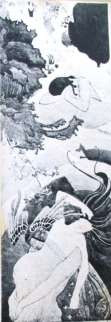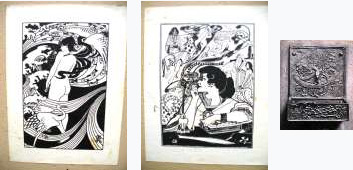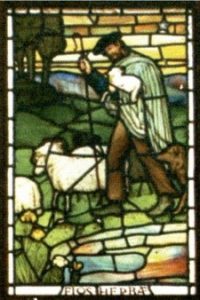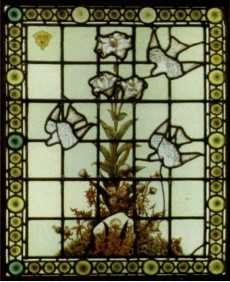GEDDES AND THE ARTS
CELTIC REVIVAL

The Celtic Revival had considerable impact in the late 19th century, especially in Ireland with the work of Yeats and his contemporaries, but it was felt in other parts of Britain as well. Geddes was the main spokesman for this movement in Scotland seeing the latent qualities of this culture as a rejuvenating force in modern society. At face value it was most evident in the field of literature given that the works of writers and poets of the “Celtic Twilight” outweighed all other material published by “Patrick Geddes and Colleagues”. However, Geddes himself envisaged the movement in more comprehensive terms, believing that Celticism and its traditional links with the Northern landscape would restore a sense of reverence and wonder in the face of nature, providing the basis for a spiritual or cultural regeneration equivalent to the civic one of the earlier slum improvements. The painters of the Old Edinburgh School of Art had a crucial role to play here, depicting the myths and legends of Celtic folklore in murals throughout the houses of the Old Town. Ramsay Lodge, originally a student hall of residence still contains a cycle of murals depicting the “History of the Gad” from ancient to modern times.
SPIRITUAL HISTORY
The combination of Geddes’ interest in the historical background of a place and his belief in the power of images to communicate complex information gave rise to several unusual projects throughout his life. The two emblems, Arbor Saeculorum and Lapis Philosophorum stand alongside the Valley Section as symbols of the basis and process of his thought. All three were made up as stained glass windows, displayed on the stairs of the Outlook Tower to assist in the interpretation of the various rooms, but the quasi mystical quality of the “Tree” and “Stone” suggest an aspect of his philosophy which is often overlooked. In classical mythology Geddes saw essential truths about nature and the world which did not conflict with his scientific training. Olympus, the book on which he was working at the end of his life, was intended to elaborate this theme. Likewise, in the regional surveys he was as receptive to the merging of history and folklore as to the physical character of the landscape. This was the realm of “Spiritual History”, overlaid and often obliterated by the effects of industrialisation and materialism, but which Geddes hoped to reawaken with images and evocations. “The Masque of Ancient Learning” was the most famous example. Produced in Edinburgh and London these pageants of history were performed by about 65 participants in a series of tableaux interpreting the development of European thought and education.
The emblems of Geddes’ philosophy indicate his preference for symbols above the printed word to explain the relationship of different aspects of his thought. Lapis Philosophorum (the Philosopher’s Stone) co-ordinates the arts and sciences while Arbor Saeculorum (Tree of Life) displays the temporal and spiritual aspects of human history through each succeeding age.
Arbor Saecolaris and Lapis Philosophis

Of all the artists associated with Geddes, John Duncan was probably the closest, sharing his enthusiasm for both Celtic and Classical mythology. Indeed Duncan could be regarded as the interpreter of Geddes’ theories in the visual arts and in this role he painted several murals including the Orpheus series in Pitreavie Castle and the Evolution of Pipe Music in Geddes’ own flat. Duncan also modelled the small ‘Witch Well’ in which Geddes had a particular interest. Placed on a site where witches were believed to have been burned in mediæval times the story was given greater significance when a bed of ashes was discovered during the excavation for Ramsay Garden, This experience encouraged Geddes to mark the spot as a token of the mythic past and its continuing presence in modern life.

THE STAINED GLASS PANELS
Three stained glass panels, commissioned by Geddes, were preserved by the Trust and are now on display in Riddles Court.
Geddes travelled extensively around the world but always returned to the Old Town Edinburgh, where he worked out many of his ideas.
At Ramsay Gardens he had flats built to lure back to the city centre a mix of professional people. In Johnston Terrace a corner of waste ground was turned into an urban garden. At Riddle Court he ran Summer Schools and established the first self-governing students’ hostel in Europe. The Outlook Tower was set up as a centre for studying Edinburgh in its regional context.
He was conscious of the need to make people’s lives better through an attractive environment. In all he did art and decoration were important. At Riddles Court, it was a painted ceiling as found in old Scots houses; on the Castle Esplanade the Witches’ Well was modelled under Geddes’ guidance; and the houses in Ramsay Gardens are decorated with wrought iron, gilding and carved figures.
Art was decorative but, with Geddes, also had to get a message across. In his time much use was made of Celtic Art and Art Nouveau, and Geddes used symbolism to educate as well as beautify. The Geddes Trust has preserved three stained glass panels specially commissioned for these buildings. They were designed by John Duncan and may have been exhibited in the Paris Exhibition of 1900.

Flos Herbae, translated as ‘pick of the flock’, shows a shepherd with a lamb and an iris – the flower of Spring. There is a link with the Valley Section window and with the Biblical good shepherd and the lost sheep.
Flos Herbae was designed for the Outlook Tower, but Lilies was placed in Riddles Court, where Geddes held his Summer Schools, in 1889. At one level, it is simply a representation of flowers. The lily is a pure, white, rather remote and artificial flower, associated with death and funerals. Geddes, however, was a biologist who saw birth, growth, breeding and death as continuing processes. The flower and scent of the lily are necessary for the pollination and the continuation of the species. Thus he said: ‘‘Pure as a lily does not mean weak, bloodless, sexless. The lily is the most frank and open manifestation of sex in all the organic world”.

The three doves are more than symbols of peace. For Geddes they were the three ‘S’s – Sympathy, Synthesis and Synergy. Sympathy meant the feeling we have for people and the environment affected by any social problem. Synthesis is the putting together of all the factors in the case. While Synergy is the action of all who are involved working together to solve the problem and get the best result. Thus the three doves together present a course of action.
The Valley Section was originally placed in the Outlook Tower. In its original form it was the first well-known example of a geographical model – a simplification of reality which helps us to understand the real world and stimulates our thinking about it.

Geddes was greatly influenced by the ideas of Leplay on ‘Place, Work, Folk’ and the relation-ships between them. Local examples that fit the model included lead mining at Leadhills and Wanlockhead, the forests of the Border hills, sheep farms on the Pentlands, farming in East Lothian and market gardening around Musselburgh. All contributed to the life of the town which served them in its turn. For the Outlook Tower the basic diagram was turned into a warmer and less formal illustration which retained the essentials. The three “Ss” were there as well, to remind viewers how to change things for the better. Under the Valley Section were descriptive comments – Microcosm of Nature, Theatre of History, Seat of Man, Future Utopia – reflecting Geddes’ optimistic view of the world.
Since Geddes’ time there has been a revolution in transport so that people no longer need live close to their work and that goods must no longer be provided locally but can be sourced from around the world. Yet the Valley Section is still a model with resonance.
